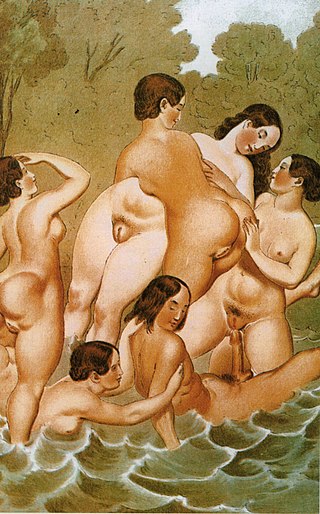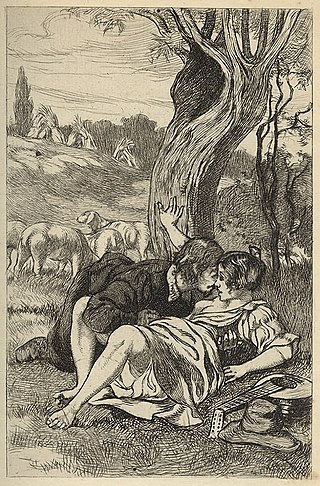Anal sex or anal intercourse is generally the insertion and thrusting of the erect penis into a person's anus, or anus and rectum, for sexual pleasure. Other forms of anal sex include anal fingering, the use of sex toys, anilingus, pegging, as well as electrostimulation and erotic torture such as figging. Although anal sex most commonly means penile–anal penetration, sources sometimes use anal intercourse to exclusively denote penile–anal penetration, and anal sex to denote any form of anal sexual activity, especially between pairings as opposed to anal masturbation.

Human sexual activity, human sexual practice or human sexual behaviour is the manner in which humans experience and express their sexuality. People engage in a variety of sexual acts, ranging from activities done alone to acts with another person in varying patterns of frequency, for a wide variety of reasons. Sexual activity usually results in sexual arousal and physiological changes in the aroused person, some of which are pronounced while others are more subtle. Sexual activity may also include conduct and activities which are intended to arouse the sexual interest of another or enhance the sex life of another, such as strategies to find or attract partners, or personal interactions between individuals. Sexual activity may follow sexual arousal.

Sexual intercourse is sexual activity involving the insertion and thrusting of the male penis inside the female vagina for sexual pleasure, reproduction, or both. This is also known as vaginal intercourse or vaginal sex. Other forms of penetrative sexual intercourse include anal sex, oral sex, fingering and penetration by use of a dildo. These activities involve physical intimacy between two or more individuals and are usually used among humans solely for physical or emotional pleasure and can contribute to human bonding.

The sexual revolution, also known as the sexual liberation, was a social movement that challenged traditional codes of behavior related to sexuality and interpersonal relationships throughout the developed Western world from the 1960s to the 1970s. Sexual liberation included increased acceptance of sex outside of traditional heterosexual, monogamous relationships. The normalization of contraception and the pill, public nudity, pornography, premarital sex, homosexuality, masturbation, alternative forms of sexuality, and the legalization of abortion all followed.

Group sex is sexual activity involving more than two people. Participants in group sex can be of any sexual orientation or gender. Any form of sexual activity can be adopted to involve more than two participants, but some forms have their own names.

Virginity is the state of a person who has never engaged in sexual intercourse. The term virgin originally only referred to sexually inexperienced women, but has evolved to encompass a range of definitions, as found in traditional, modern and ethical concepts. Heterosexual individuals may or may not consider loss of virginity to occur only through penile-vaginal penetration, while people of other sexual orientations often include oral sex, anal sex, or manual sex in their definitions of losing one's virginity.

Foreplay is a set of emotionally and physically intimate acts between one or more people meant to create sexual arousal and desire for sexual activity. Although foreplay is typically understood as physical sexual activity, nonphysical activities, such as mental or verbal acts, may in some contexts be foreplay. This is typically the reason why foreplay tends to be an ambiguous term and means different things to different people. It can consist of various sexual practices such as kissing, sexual touching, removing clothes, oral sex, sexual games, and role playing.

A sex position is a position of the body that people use for sexual intercourse or other sexual activities. Sexual acts are generally described by the positions the participants adopt in order to perform those acts. Though sexual intercourse generally involves penetration of the body of one person by another, sex positions commonly involve penetrative or non-penetrative sexual activities.

Flappers were a subculture of young Western women in the 1920s who wore short skirts, bobbed their hair, listened to jazz, and flaunted their disdain for what was then considered acceptable behavior. Flappers were seen as brash for wearing excessive makeup, drinking alcohol, smoking cigarettes in public, driving automobiles, treating sex in a casual manner, and otherwise flouting social and sexual norms. As automobiles became more available, flappers gained freedom of movement and privacy.

The missionary position or man-on-top position is a sex position in which, generally, a woman lies on her back and a man lies on top of her while they face each other and engage in vaginal intercourse. The position may also be used for other sexual activity, such as anal sex. It is commonly associated with heterosexual sexual activity, but is also used by same-sex couples.

Premarital sex is sexual activity which is practiced by people before they are married. Premarital sex is considered a sin by a number of religions and also considered a moral issue which is taboo in many cultures. Since the Sexual Revolution of the 1960s, it has become accepted by certain liberal movements, especially in Western countries. A 2014 Pew study on global morality found that premarital sex was considered particularly unacceptable in "Muslim Majority Countries", such as Malaysia, Jordan and Pakistan, each having over 90% disapproval, while people in Western European countries were the most accepting, with Spain, Germany, and France expressing less than 10% disapproval.
Bundling, or tarrying, is the traditional practice of wrapping a couple together in a bed sometimes with a board between the two of them, usually as a part of courting behavior. The tradition is thought to have originated either in the Netherlands or in the British Isles and later became common in colonial United States, especially in Pennsylvania Dutch Country. Bundling is associated with the Amish as a form of courtship.

Mammary intercourse is a sex act, performed as either foreplay or as non-penetrative sex, that involves the stimulation of a man's penis by a woman's breasts and vice versa. It involves placing the penis between a woman's breasts and moving the penis up and down to simulate sexual penetration and to create sexual pleasure.
Casual sex is sexual activity that takes place outside a romantic relationship and implies an absence of commitment, emotional attachment, or familiarity between sexual partners. Examples are sexual activity while casually dating, one-night stands, prostitution or swinging.

Non-penetrative sex or outercourse is sexual activity that usually does not include sexual penetration. It generally excludes the penetrative aspects of vaginal, anal, or oral sex, but includes various forms of sexual and non-sexual activity, such as frottage, manual sex, mutual masturbation, kissing, or cuddling. Some forms of non-penetrative sex, particularly when termed outercourse, include penetrative aspects, such as penetration that may result from forms of fingering or oral sex.

Lesbian sexual practices are sexual activities involving women who have sex with women (WSW), regardless of their sexual orientation. A woman who has sex with another woman may identify as a lesbian if she is exclusively sexually attracted to women, or bisexual if she is not exclusively sexually attracted to women, or dispense with sexual identification altogether. The term may also be applied to a heterosexual or asexual woman who is unsure of or is exploring her sexuality.

Armpit fetishism is a type of partialism in which a person is sexually attracted to armpits, which may lead to armpit intercourse.

A handjob is a manual sex act involving a person stimulating the penis or scrotum of another by using the hand. This is done to induce an erection for sexual pleasure, sexual arousal and may result in orgasm and ejaculation.

In American slang, baseball metaphors for sex are often used as euphemisms for the degree of physical intimacy achieved in sexual encounters or relationships. In the metaphor, first prevalent in the aftermath of World War II, sexual activities are described as if they are actions in a game of baseball. Baseball has also served as the context for metaphors about sexual roles and identity.
Hookup culture is one that accepts and encourages casual sex encounters, including one-night stands and other related activity, without necessarily including emotional intimacy, bonding or a committed relationship. It is generally associated with Western late adolescent sexuality and, in particular, United States college culture. The term hookup has an ambiguous definition because it can indicate kissing or any form of physical sexual activity between sexual partners. The term has been widely used in the U.S. since at least 2000. It has also been called nonrelationship sex, or sex without dating.
















